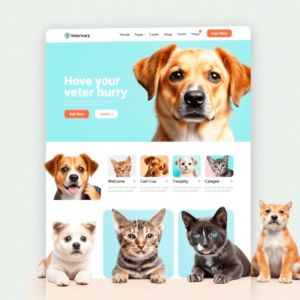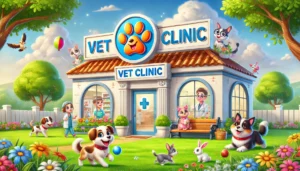Introduction
In the world of veterinary marketing, engaging veterinary blog content is crucial for attracting pet owners. Compelling content not only draws readers in but also establishes your practice as a trusted authority in pet care.
Quality blog posts can educate pet owners on health, nutrition, and behavior, creating a lasting bond.
Effective tactics include storytelling, seasonal advice, informative guides, visuals, SEO optimization, and interactive elements.
Unlock the secret to captivating your audience and ensuring they return for more insight and guidance.
1. Understand Your Audience
Identifying the Interests and Needs of Pet Owners
Creating engaging veterinary blog content begins with a deep understanding of your audience. An audience needs assessment is crucial to determine what pet owners seek from veterinary services. Pet owners are passionate about their furry companions, and this passion drives their search for knowledge and support.
Common Concerns Among Pet Owners
Pet owners commonly have concerns in several key areas:
- Health: Pet health is paramount. Topics like common illnesses, preventive care, and emergency response resonate strongly.
- Nutrition: Understanding what to feed pets can be confusing. Blogs on balanced diets, ingredient analysis, and specific dietary needs address this concern effectively.
- Behavior: Behavioral issues can strain the human-animal bond. Providing insights on training tips, anxiety management, and socialization techniques can be invaluable.
By aligning your content with these interests and concerns, you create a connection that fosters trust and loyalty among your readers. This insight allows you to tailor your content strategy to meet the exact needs of pet owners, positioning your veterinary practice as an indispensable resource.
2. Craft Engaging Veterinary Blog Topics
Utilizing Storytelling Techniques to Connect with Readers
Storytelling in veterinary care is a powerful tool to forge emotional connections with readers. When you share compelling narratives about real-life experiences, pets, and their owners, you do more than just inform—you create an emotional resonance that can lead to stronger client relationships.
Benefits of using storytelling to engage readers emotionally:
- Humanizing Your Practice: Sharing stories about the pets you’ve treated and their journeys makes your practice relatable. It adds a personal touch that statistics and facts alone can’t convey.
- Building Trust: Real-life anecdotes highlight your expertise and compassion. When pet owners see how you’ve helped others, they’re more likely to trust you with their own pets.
- Encouraging Engagement: Stories invite comments, shares, and discussions. They turn passive readers into active participants who are eager to connect.
- Simplifying Complex Information: Narratives can make complex medical information more digestible. By framing it within a story, you help pet owners understand and remember critical details.
Seasonal Content Ideas for Your Veterinary Blog Content
Creating content around seasonal issues in pet care is another effective strategy for crafting engaging blog topics. Seasonal posts are timely and relevant, providing valuable advice when pet owners need it most.
Examples of seasonal content ideas:
- Summer Safety Tips: Discuss the dangers of heatstroke, how to keep pets cool, and tips for safe outdoor activities.
- Winter Pet Care Advice: Focus on protecting paws from ice and salt, keeping pets warm, and indoor activity ideas during colder months.
- Holiday Hazards: Highlight potential dangers during holidays like Christmas or Halloween—think toxic foods, decorations, and costumes that might stress or harm pets.
- Spring Cleaning: Offer guidance on pet-safe cleaning products and tips for managing shedding as the weather warms up.
Seasonal topics not only provide timely advice but also show that your practice is attuned to the changing needs of pets throughout the year.
Engaging blog topics rooted in storytelling techniques and seasonal relevance ensure your content resonates deeply with pet owners. These strategies lay the foundation for informative and educational content that will hold your audience’s attention while addressing their specific concerns.
Seasonal Ideas for Your Veterinary Blog Content
Engaging blog content topics can capture the attention of pet owners by addressing seasonal issues in pet care. Selecting relevant and timely topics for your audience ensures your content remains fresh and valuable. Consider these ideas:
Summer Safety Tips
- Hydration Essentials: Discuss the importance of keeping pets hydrated during hot weather.
- Heatstroke Prevention: Provide signs to watch for and emergency steps to take.
- Traveling with Pets: Offer advice on safe car travel and pet-friendly vacation spots.
Winter Pet Care Advice
- Cold Weather Protection: Share tips on safeguarding pets from frostbite and hypothermia.
- Indoor Activity Ideas: Suggest engaging indoor play options to keep pets active during colder months.
- Holiday Hazards: Highlight common holiday-related dangers like toxic foods or decorations.
Addressing frequently asked questions (FAQs) in pet care through seasonal content helps build a connection with your readers, positioning your veterinary practice as a trusted source. By focusing on current challenges, you demonstrate an understanding of their needs, fostering loyalty and trust.
3. Produce Informative and Educational Content for Pet Owners
Pet owners seek reliable information to ensure their furry friends lead healthy, happy lives. Crafting informative veterinary blog content posts that address their needs can position your veterinary practice as a trusted authority.
Writing Guides on Choosing the Right Food or Understanding Common Procedures
Creating comprehensive guides helps demystify complex topics for pet owners. For instance:
- Choosing the Right Food: Develop a detailed guide that explores different types of pet food, nutritional requirements, and tips for selecting high-quality products. Highlight common dietary issues and how to address them.
- Understanding Common Procedures: Break down routine veterinary procedures like vaccinations, dental cleanings, or spaying/neutering. Use simple language and clear explanations to alleviate any anxiety pet owners might have.
Providing Preventive Care Tips to Empower Pet Owners
Empower pet owners with knowledge of preventive care through actionable tips and advice:
- Regular Health Check-ups: Emphasize the importance of annual vet visits and what pet owners can expect during these check-ups.
- Vaccination Schedules: Provide a detailed vaccination timeline tailored to different types and breeds of pets.
- Routine Grooming: Offer practical grooming tips to maintain their pet’s skin, coat, and overall hygiene.
- Behavioral Training: Share insights on addressing common behavioral issues such as separation anxiety or aggression, and the benefits of early training.
Educational veterinary blog content for pets not only informs but also builds trust with your audience. By arming them with valuable knowledge, you foster a sense of empowerment that encourages proactive care.
4. Understand The Role of Visual Storytelling
Visual storytelling transforms routine veterinary blog content into captivating narratives that resonate deeply with pet owners. Integrating visuals in veterinary blog content is essential for several reasons.
The Importance of Images and Infographics in Enhancing Engagement
- Capturing Attention: High-quality images draw readers in, making your veterinary blog content stand out amidst a sea of text-heavy content.
- Simplifying Complex Information: Infographics break down intricate topics like pet health statistics or step-by-step care procedures into easily digestible visual formats.
- Creating Emotional Connections: Photos of pets and their owners foster an emotional bond, driving home the message that your practice genuinely cares about its furry patients.
Best Practices for Effectively Using Visuals to Complement Written Content
- Relevance and Quality: Ensure all visuals are relevant to the content and of high quality. Blurry or unrelated images can detract from the professionalism of your blog.
- Balanced Layout: Use a mix of text and visuals to maintain reader interest. For instance, pair a detailed article on pet nutrition with an infographic summarizing key points.
- Consistency in Style: Maintain a consistent visual style across all blog posts. This includes using similar color schemes, fonts, and image types, reinforcing your brand identity.
- Alt Text for SEO: Always include descriptive alt text for images. This practice enhances accessibility and boosts SEO by helping search engines understand the content of your visuals.
By leveraging visual storytelling techniques, veterinary blog content can create richer, more engaging experiences that keep pet owners coming back for valuable insights and advice.
5. Implement SEO Best Practices for Veterinary Blog Content
SEO optimization is a critical component in ensuring your veterinary blog reaches the right audience. By integrating best practices for SEO in veterinary blog content, you enhance visibility and engagement.
Strategic Keyword Integration
Keywords are the backbone of SEO. Integrate them seamlessly throughout your content to align with what pet owners are searching for:
- Primary Keywords: Use primary keywords such as “veterinary care,” “pet health,” or “animal nutrition” in your titles, headers, and introductory paragraphs.
- Secondary Keywords: Include related terms like “dog wellness tips” or “cat dietary advice” within the body of your posts to capture long-tail search traffic.
- Natural Placement: Ensure keywords fit naturally within the content. Forced keywords can disrupt readability and harm user experience.
Meta Descriptions and Alt Tags
Meta descriptions and alt tags play a pivotal role in SEO by providing context to search engines about your veterinary blog content:
- Meta Descriptions: Craft compelling meta descriptions that succinctly summarize each blog post. These should be around 150-160 characters and include your primary keyword for optimal results.
Example: “Discover essential summer safety tips for pets with our expert guide. Learn how to keep your furry friend safe during the hot months.“
- Alt Tags: Use descriptive alt tags for all images. This not only improves accessibility but also boosts SEO by allowing search engines to understand images in your veterinary blog content.
Example:

By focusing on these elements, you ensure your veterinary blog content is both search-friendly and valuable to readers, paving the way for greater online visibility and engagement.
6. Encouraging Engagement with Calls-to-Action and Building Trust with Personal Stories
Creating Effective CTAs
Calls-to-action (CTAs) are crucial in guiding your audience to take desired steps. A well-crafted CTA can transform a passive veterinary blog content reader into an active participant. Consider these strategies:
- Appointment Scheduling: Direct prompts like “Book Your Pet’s Appointment Today” create a sense of urgency.
- Newsletter Sign-Ups: Encourage engagement with phrases such as “Stay Updated with Our Latest Pet Care Tips”.
- Social Media Interaction: Foster community by inviting readers to “Follow Us for Daily Pet Health Tips”.
Including buttons or links that stand out visually ensures they capture attention and drive action.
Sharing Real-Life Experiences
Personal stories resonate deeply, building trust and fostering a genuine connection. Highlighting patient success stories and testimonials from clients not only showcases your expertise but also humanizes your practice.
“After a difficult diagnosis, Dr. Smith’s care transformed Bella’s life. We’re forever grateful!” — The Johnson Family
These narratives can be powerful tools:
- Authenticity: Real stories validate the quality of care provided.
- Relatability: Potential clients relate to familiar challenges and triumphs.
- Credibility: Testimonials establish your clinic as a trusted authority in veterinary care.
Integrating these elements within your blog posts creates a compelling narrative that engages the audience emotionally, motivating them to choose your services.
7. Maintain Consistency in Content Publishing and Exploring Interactive Veterinary Blog Content Strategies
Consistency is Key
A well-structured content calendar serves as the backbone of any successful veterinary blog. By establishing a content calendar, you ensure regular updates that keep your audience engaged and informed. This method helps in planning and scheduling posts, maintaining a steady flow of information that aligns with your strategic goals.
Benefits of Regular Updates:
- Enhanced Engagement: Frequent posts keep readers coming back for fresh content.
- Improved SEO: Search engines favor websites that consistently update their content.
- Brand Authority: Regularly published content positions you as an industry leader.
Interactive Content
Creating interactive content like quizzes or polls related to pet care can significantly boost reader engagement. These elements not only make the blog more engaging but also provide valuable insights into your audience’s preferences and concerns.
Why Interactive Content Works:
- Encourages Participation: Readers are more likely to engage with content that requires their input.
- Data Collection: Quizzes and polls can gather useful data on pet owners’ needs and interests.
- Shareable Content: Interactive elements are often shared on social media, increasing your reach.
“Consistency and interactivity transform your veterinary blog from a static information source into a dynamic community hub.”
By focusing on these strategies, you create a compelling, informative, and engaging platform for pet owners.
8. Leverage Social Media Platforms and Collaborate with Influencers
Expanding Your Reach through Social Media
Social media platforms are crucial for promoting veterinary blog content and connecting with a wider audience. To make the most of your reach, try these strategies:
- Tailored Content for Each Platform: Adjust your content to fit the unique dynamics of different social channels. For example, use visually appealing images and short videos on Instagram, while saving detailed articles for LinkedIn.
- Consistent Posting Schedule: Maintain a regular posting schedule to keep your audience engaged. Tools like Hootsuite or Buffer can help you stay organized and ensure you never miss an opportunity to connect with your followers.
- Interactive Posts: Use polls, Q&A sessions, and live streams to foster direct interaction with your audience. These formats not only engage but also provide valuable insights into what pet owners are currently interested in.
Collaborating with Local Pet Influencers
Partnering with local pet influencers or animal shelters can greatly expand your reach and establish credibility within the community:
- Mutual Benefits: Such collaborations offer mutual benefits. Influencers gain valuable content for their followers while you gain access to their established audience. This symbiosis enhances visibility and attracts potential clients who trust the influencer’s recommendations.
- Authentic Engagement: Influencers bring authenticity to your brand. Their genuine passion for pets resonates with their followers, creating a more personal connection than traditional advertising methods.
- Community Events: Collaborate on local events or online campaigns that highlight pet care tips or success stories. This not only drives traffic to your blog but also strengthens community ties.
By using these strategies, you position your veterinary blog as both a trusted resource and an engaging digital presence in the pet care community.
Conclusion
Engaging veterinary blog content isn’t just a marketing tactic; it’s the cornerstone of a compelling content strategy for veterinarians. By understanding your audience and crafting blog posts that address their specific needs and concerns, you create a platform that educates, builds trust, and fosters lasting relationships.
Key Takeaways:
- Empathy: Addressing common pet owner concerns with empathy creates a strong emotional connection.
- Education: Providing informative guides empowers pet owners to make better decisions.
- Visuals: Utilizing images and infographics enhances engagement and comprehension.
- Consistency: Maintaining a regular posting schedule keeps your audience engaged and informed.
When executed effectively, these strategies not only attract but also retain pet owners, making your veterinary practice an indispensable resource in their lives.
Want to take the pressure off your practice and let someone else handle your veterinary blog content? Contact AVI Lead Generation today, and schedule a no-pressure consultation to see if we can help your online presence.








